Drug Development through Modeling and Simulation - the Business Case
The drug development process has been seen as inefficient and disappointing by those in the R&D space. Model and Simulation provides a potential relief to these issues by delivering significant business, scientific and clinical value to drug developers.
Well-defined patient populations bring efficiency to drug development and higher commercial value to precision drugs (labels)-the new blockbuster
The inefficiencies of the drug development process are well understood by those in pharmaceutical R&D. While R&D spending levels continue to increase, the number of new drug approvals and the return on investment (ROI) of R&D spend has been disappointing. This negative cycle has spurred management to explore ways to minimize drug development time, manage costs and improve the probability of commercial success.
Modeling and simulation (M&S), also known as biosimulation or model-informed drug discovery and development (MID3), can deliver significant business, scientific and clinical value to firms that fully utilize it as an integral part of their drug development strategy. M&S has the ability to influence every phase of the drug development process, including the commercial decisions around the benefits of even bringing a specific drug to market. In doing so, M&S provides a pathway toward lowering the cost and ROI of R&D investment while optimizing crucial drug development decisions. Further, global regulatory agencies are active users and advocates of M&S. M&S is included in FDA’s published strategic priorities and is expected to be incorporated in the 2017 PDUFA reauthorization.
In the target therapeutic areas of most interest for the industry today – oncology and rare/orphan diseases – increasing speed to launch and efficiency of development literally means the difference between life and death for patients. Furthermore, often, conducting trials is lengthy, impractical and even unethical. In those cases, M&S is often the only way to go.
The time and cost saving aspects of M&S using case examples along with results from actual trial data of several recently approved drugs are discussed in this paper. A tool for calculating the likely commercial benefit of accelerating product commercial launch is shared.
Modeling and simulation value generation
Modeling and simulation has already had a profound impact on drug development (Table 1). And while important efforts have been made to assess the financial impact of M&S in R&D, its full benefits are not yet fully understood, quantified or leveraged across the many facets of the drug development process.
In many instances, M&S creates value by avoiding costs. For example, “In the past three years, the M&S group at Merck delivered more than half a billion dollars in cost avoidance, and it continues to enable approximately 10 critical decisions each year.”1 In other words, a critical best practice element in leveraging the transformative value of M&S is in identifying “losers” earlier and making better and smarter investments in potential winners and enable launching those winners more quickly.
M&S models are leveraged for many purposes-to assess drug safety and efficacy, determine first-in-human dosing, plan clinical trial design, and determine comparative effectiveness and the likelihood of commercial success. M&S integrates knowledge and relationships between the disease, drug characteristics, patient populations and clinical trial parameters. More than 15 regulatory guidance documents incorporate M&S as a best practice, and data generated from these in silico techniques have been incorporated into drug labels in increasing measure.
Though difficult to calculate, the value of label specificity in reimbursement decisions can also be substantial. Payers generally dislike ambiguity or uncertainty in the label, and the use of a product, because it is difficult to “manage” and anticipate costs. Allowing payers to understand the sub-populations in which the product is most likely to result in positive outcomes, and under which circumstances (e.g. dosing, concomitant meds, etc.), can provide a level of assurance of appropriate use, which can make reimbursement decisions happen more quickly and more favorably. Adding clarity to a label can also make it easier for providers and patients to use and understand the medication, allowing for more rapid uptake and a greater level of satisfaction with the product. Providing specific and accurate information on dosing, drug interactions, or patient subpopulation information increases the value of the product to users and payer alike, which will increase its use over time.2
Moreover, M&S can help increase the commercial value of a new medication (by building better understanding of drug-drug interactions (DDI), dosing for different populations, addressing agency questions, etc.), as well as enabling an early-to-market positioning for medications which yield higher pricing and greater likelihood of reimbursement. Taken together, these factors can significantly improve the ROI of research activities.
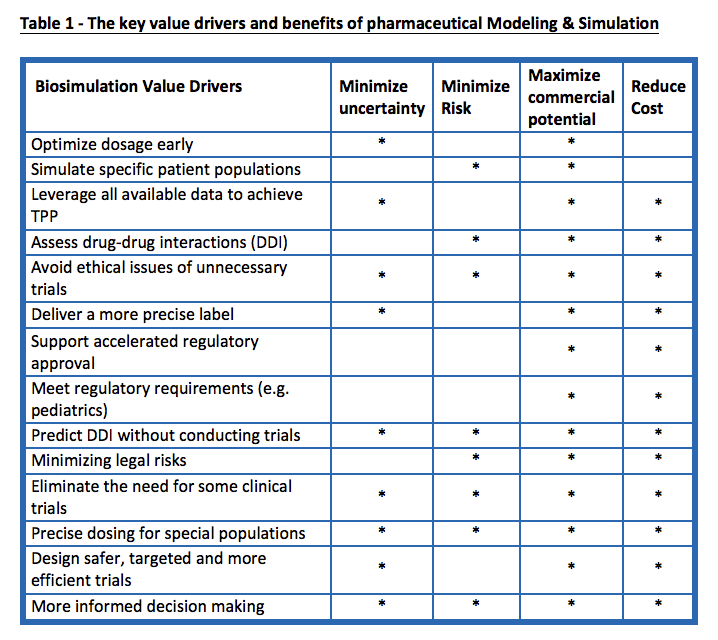
Commercial benefits
Bringing a product to market as quickly as possible is of great value, but the magnitude of that value or the source of that value may not be so obvious. Typically, we attribute the value to the net present value (NPV) benefits of earlier drug product revenue and the extended period of exclusivity. Through the development of models that consider the product’s potential in the marketplace, its anticipated approval time, and other key market information, we have measured the NPV of earlier approval and launch for products under an array of market conditions.
Accelerating a product’s time to market may have other positive effects as well – if the acceleration to approval can mean getting to the market sooner than a competitor the value can be even greater than the basic savings in time. Changing the order of entry into the market can do increase its peak year sales by getting to the market before similar competitors and it may also increase the rate of market adoption, which will substantially increase the value of the product. Researchers at Duke University conducted studies that have determined that a change in order of entry position of one slot will increase the peak sales from 40% to 100%, depending on whether you expect to be fourth or later to the market or second or third.3 Regardless of position, any improvement in the order of entry of a product will have substantial benefits. Even in the most conservative case, a single month of time savings can yield millions in value.
We built a model to reflect both of these phenomena based on actual performance of products introduced in the last five years. The model, which is described in Table 2, provides the details of the NPV improvement for products with different rates of expected market uptake. For an “average” product, which would be expected to reach its peak sales volume in roughly six years, improving its time to market entry by a single calendar quarter would increase the NPV of that asset by roughly five percent. To monetize that figure, assume that product would be expected to achieve peak sales of $500 million and have an eight-year patent life. Using an 8% discount rate, the monetary value of a one calendar quarter improvement in time to market is worth $74 million. For a product that would be expected to gain use at a faster rate and reach peak earlier, that NPV improvement would be as high as $88 million.
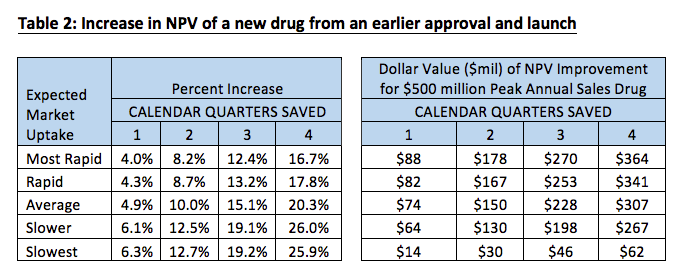
As can be seen, even for a product that is not expected to be a “star,” simply speeding its’ time to market by one calendar quarter can generate significant additional revenue, greatly improving the value of the asset.
By increasing the rate of market uptake to one that is slightly faster, the NPV of that asset will increase by nearly 27% before the time value of the NPV improvement is considered. For products with expected uptake rates that are below average the increase in the NPV value of an increase in uptake is even more substantial – which means that the use of M&S for late entrants to the market could substantially increase their opportunities for financial success, while for product that will enter the market before competitors the value of gaining earlier approval in itself warrants the use of this technique. Table 3 shows the increase in asset NPV that is realized when the rate of product uptake is improved – either because the order of entry of the product has improved or because the specificity of and information in the label has allowed such an increase.
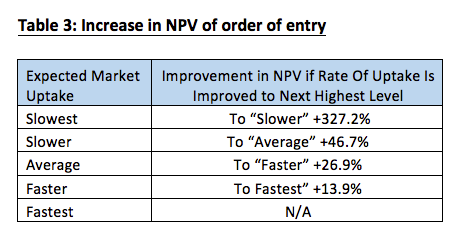
The relevance of this analysis is that by systematically and purposefully incorporating M&S into the drug development process, this type of acceleration can be achieved. For example, M&S can be used to fine-tune inclusion and exclusion criteria in a phase III trial, thus reducing the time and cost of that trial. Alternatively, by leveraging in silico technology in lieu of certain DDI trials, the development cycle will be reduced, oftentimes by many months. Further, there is a natural overlap between drugs that have leveraged M&S and those that have benefited from FDA’s accelerated, breakthrough, priority and fast-track review processes. In short, by using M&S to optimize decisions along the drug development process, both time and cost will often be reduced, facilitating an earlier launch.
Impact on clinical trials
Clinical development management has concentrated in recent years on simplifying the design and execution of clinical trials, usually the longest and most costly expense in the entire R&D process. For instance, there are measurable financial and study completion costs to a larger number of patients in a Phase III study. In addition, more enrolled study patients lengthens study completion times across all therapeutic areas. Similarly, as the number of clinical sites and countries involved in that study increase, so do study completion times. Even the number of inclusion/exclusion criteria in the study protocol has a measurable dilatory impact on study completion times.4 Study design has a major effect on study completion times and drug development productivity.
An analysis of three recently approved drugs (NDA/BLA) is illuminating. The three used M&S in their clinical development program: aripiprazole (Aristida), pembrolizumab (Keytruda); cobimetinib (Cotellic). All three have generally required fewer patients and to have frequently finished their individual clinical trials more quickly than comparable compounds that did not appear to use M&S to the extent that these did.
We used FDA documents and the federally mandated database ClinicalTrials.gov. These analyses can be replicated by any third party. Missing data did not exceed 3%. We were able to identify and quantify all Phase 0-III clinical trials for the three study drugs and their corresponding comparators drugs used in the respective FDA new drug approval process.
Cotellic (cobimetinib) clinical trials, along with its comparators, examined multiple cancer indications in the same study. The reported number of enrolled patients in cobimetinib clinical trials was a fraction of those of the comparator drugs. According to IMS Health data, the total average clinical grant cost differences between cobimetinib and its comparators drugs is $145 million. Clinical grant costs are traditionally held to constitute about one-third of total clinical trial costs. Hence, the total study cost differences are even more substantial, probably in the area of $435 million.
The comparators reported a number of studies where they did not provide the specific study phase. We know that the comparators did report separate Phase IV studies. Hence, these unspecified studies were allocated across the study phases for each comparator by the actual distributions reported for each comparator drug, a convention followed throughout the analysis.
Equally striking, is the pronounced difference in study completion times between cobimetinib and its comparators. Study completion time is defined as the difference in days between the date of the first patient’s first visit, to the date of the last patient’s first visit. Smaller studies have smaller clinical grant and other study costs, but fewer patients translates into fast study completion times.4 This clearly appears to be the case with cobimetinib.
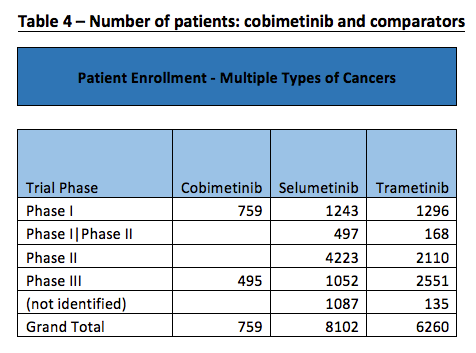
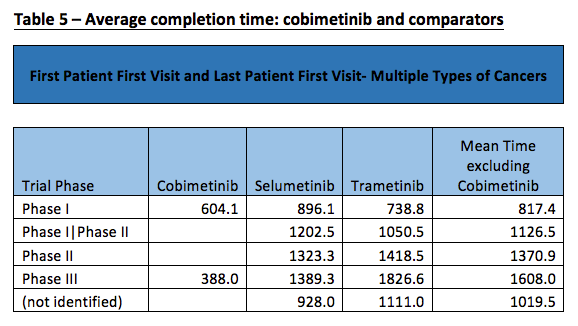
Keytruda (a PD-1 inhibitor) studies enrolled fewer patients than Avastin studies, and more than Herceptin studies, especially earlier in the clinical trial process (Table 6). This has a distinct effect on overall clinical trial grant costs. Any clinical cost difference between Keytruda and Herceptin is minimal. There is a major difference though between Keytruda and Avastin, probably in the area of $350 million in clinical grants, and $1 billion in total clinical trial costs.
The data in Table 7 shows that Keytruda studies had consistently shorter completion times in the later phase clinical trials, the most time consuming part of the clinical develop program.
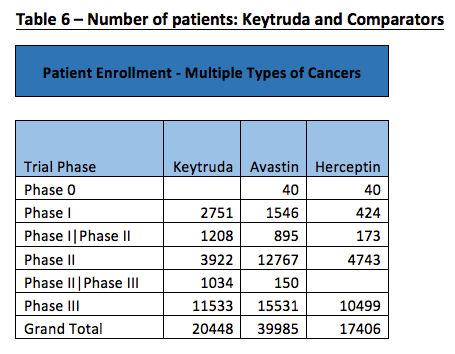
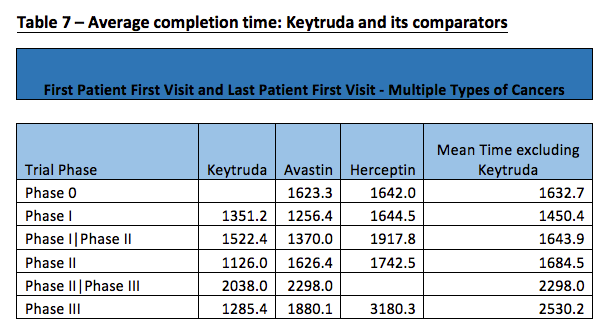
Aristada, an extended release injection approved as a new chemical entity for schizophrenia, had no Phase II studies. Aristada studies enrolled a fraction of the patients enrolled in the two phases where clinical trials were conducted. Clinical trial grant average cost differences are substantial, $326 million, with total clinical trial cost differences substantially higher at an estimated $978 million.
Aristada leveraged M&S for assessing DDI impact as well as formulation development. Aristada studies completion times are generally faster than two of its comparators and somewhat longer than the other two comparators.
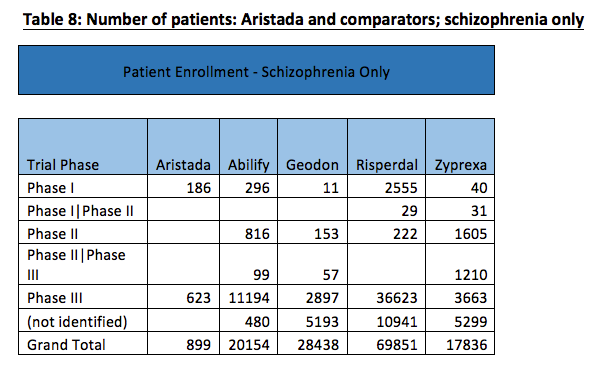
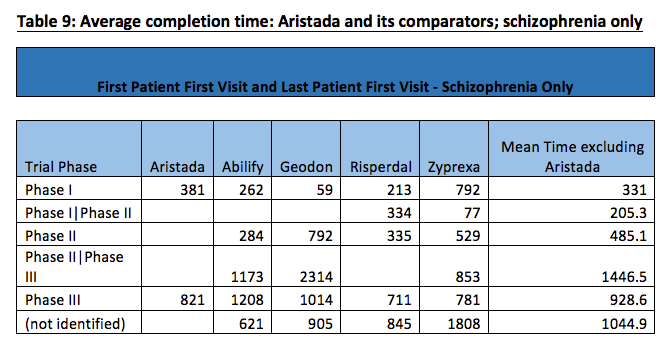
It is rarely possible to eliminate all other confounding variables in a retrospective study. For example, the individual clinical trials included in this analysis were conducted at different times, by different organizations, often in different places. However, this analysis is unique in that it draws upon all the Phase 0-III clinical trials used in the approval process for all three drugs and every comparator drug included in the analysis.
The directional results are clearly consistent with those of other studies measuring the benefits of modelling and simulation.1,5 In this instance, three drugs that used M&S obtained FDA approval with studies that were generally smaller and completed more quickly than their respective comparator drugs.
The cost savings stand out. In recent years, management has come to appreciate the wasted opportunity costs of unnecessary patients along with avoidable clinical grant and study expenditures. Important clinical studies and market support activities may have been needlessly forgone because of needless patient enrollment costs.
The consistently shorter study completion times of the three study drugs is also clear. To draw upon Benjamin Franklin, everyone in drug development knows that a day saved is a lot of money earned.
Conclusion and Summary
While scientists working in R&D have an understanding of at least some of the benefits of M&S as a strategic lever in drug development, the executive management within the biopharma industry may be unaware of its reach. For example, 90% of the 2015 new drugs and biologics approved by FDA leveraged M&S for dose selection, safety determinations, trial design, bridging studies, and the scores of drug label statements were determined using M&S versus in vivo clinical trials. The global regulators are clearly encouraging the integration of M&S into drug development programs. Beyond the scientific value, the financial ROI of integrating M&S has not been well assessed and aggregated, and it certainly has not been well articulated. The factors influencing value that are leveraged by M&S are: time of entry as measured by month; order of entry; rate of uptake; and specificity of the information in the label. This paper has enabled us to not only review the many drug development decisions that can be optimized by M&S, but objectively look at the impact of M&S on the key elements of time, cost, and the ROI of pharma R&D.
E.M. Kolassa, MBA and PhD, Chairman & Managing Partner, MME, Harold E. Glass, PhD, Dean's Professor, University of the Sciences in Philadelphia, Edmundo Muniz, MD, PhD, Chief Executive Officer, Certara
*All tables should be sourced to: Harold Glass, using ClinicalTrials.gov data, 2016
References
- Allerheiligen, SRB. Impact of Modeling and Simulation: Myth or Fact? Clinical Pharmacology & Therapeutics, Volume 96 Number 4, October 2014.
- Kolassa, EM, The Strategic Pricing of Pharmaceuticals, Oxford Pondhouse Press, 2009.
- Ridley, DB et al. Forecasting Market Share in the US Pharmaceutical Market. Nature Reviews. Vol 14, Sept 2015.
- Glass, H et al. Pharmaceutical Organizational Size and Phase 3 Clinical Trial Completion Times. DIA Therapeutic Innovation & Regulatory Science 1-7, 2016.
- Milligan, Model-Based Drug Development: A Rational Approach to Efficiently Accelerate Drug Development. Nature/CPT. Volume 93 Number 6, June 2013.
Improving Relationships and Diversifying the Site Selection Process
April 17th 2025In this episode of the Applied Clinical Trials Podcast, Liz Beatty, co-founder and chief strategy officer, Inato, discusses a number of topics around site engagement including community-based sites, the role of technology in improving site/sponsor relationships, how increased operational costs are impacting the industry, and more.
Behind the Buzz: Why Clinical Research Leaders Flock to SCOPE Summit
February 7th 2025In this episode, we meet with Micah Lieberman, Executive Conference Director for SCOPE Summit (Summit for Clinical Ops Executives) at Cambridge Innovation Institute. We will dive deep into the critical role of collaboration within the clinical research ecosystem. How do we bring together diverse stakeholders—sponsors, CROs, clinical trial tech innovators, suppliers, patients, sites, advocacy organizations, investors, and non-profits—to share best practices in trial design, program planning, innovation, and clinical operations? We’ll explore why it’s vital for thought leaders to step beyond their own organizations and learn from others, exchanging ideas that drive advancements in clinical research. Additionally, we’ll discuss the pivotal role of scientific conferences like SCOPE Summit in fostering these essential connections and collaborations, helping shape the future of clinical trials. Join us as we uncover how collective wisdom and cross-industry partnerships are transforming the landscape of clinical research.
FDA-Approved Gene Therapy Beqvez Shows Sustained Efficacy, Safety in Long-Term Hemophilia B Trial
April 17th 2025Beqvez (fidanacogene elaparvovec), an FDA-approved one-time gene therapy for hemophilia B, demonstrated sustained factor IX expression, low bleeding rates, and a favorable safety profile over long-term follow-up.